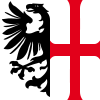Flags of the Holy Roman Empire


The Flag of the Holy Roman Empire was not a national flag, but rather an imperial banner used by the Holy Roman Emperor; black and gold were used as the colours of the imperial banner, a black eagle on a golden background. After the late 13th or early 14th century, the claws and beak of the eagle were coloured red. From the early 15th century, a double-headed eagle[1] was used.
In 1804, Napoleon Bonaparte declared the First French Empire. In response to this, Emperor Francis II of the Habsburg dynasty declared his personal domain to be the Austrian Empire and became Francis I of Austria. Taking the colours of the banner of the Holy Roman Emperor, the flag of the Austrian Empire was black and gold. Francis II was the last Holy Roman Emperor, with Napoleon forcing the empire's dissolution in 1806. After this point, these colours continued to be used as the flag of Austria until 1918.
The colours red and white were also significant during this period. When the Holy Roman Empire took part in the Crusades, a war flag was flown alongside the black-gold imperial banner. This flag, known as the "Saint George Flag", was a white cross on a red background: the reverse of the St George's Cross used as the flag of England.[1] Red and white were also colours of the Hanseatic League (13th–17th centuries). Hanseatic trading ships were identifiable by their red-white pennants and most Hanseatic cities adopted red and white as their city colours (see Hanseatic flags). Red and white still feature as the colours of many former Hanseatic cities such as Hamburg or Bremen.
In northern Italy, during the Guelph and Ghibelline conflict of the 12th to 14th centuries, the armies of the Ghibelline (pro-imperial) communes adopted the war banner of the Holy Roman Emperor (white cross on red) as their own, while the Guelf (anti-imperial) communes reversed the colours (red cross on white). These two schemes are prevalent in the modern civic heraldry of northern Italian towns and remains a revealing indicator of their past factional leanings. Traditionally Ghibelline towns like Pavia, Novara, Como, and Asti continue to display the Ghibelline cross. The Guelf cross can be found on the civic arms of traditionally Guelf towns like Milan, Vercelli, Alessandria, Reggio, and Bologna.
Imperial Banners
According to Meyers Konversations-Lexikon of 1897 (s. v. "Banner"), the German Imperial Banner at the time of Henry I and Otto the Great depicted the Archangel Michael; at the time of Frederic Barbarossa, an eagle; at the time of Otto IV an eagle hovering over a dragon, and since the time of Sigismund (1430s), and "perhaps earlier", the Imperial Eagle, viz. a black eagle in a yellow field, bearing the arms of the emperor's house on its breast.
| Flag | Date | Use | Description |
|---|---|---|---|
.svg.png) | c. 1430–1806 | Imperial Banner of the Holy Roman Emperor | Or, a double-headed imperial eagle displayed with a halo sable armed and langued gules |
.svg.png) | 1437–1493 | Imperial Banner of Frederick III | The imperial banner with an escutcheon of the coat of arms of Frederick III |
.svg.png) | 1493–1556 | Imperial Banner of Maximilian I and Charles V | The imperial banner with an escutcheon of the coat of arms of Maximilian I |
War flag
The Imperial War Flag or Reichssturmfahne, was smaller than the imperial banner, carried before the emperor or his appointed commander in battle. One such war flag was the St. George's Flag, showing a white St. George's cross on a red field, frequently with a Schwenkel.[2]
| Flag | Date | Use | Description |
|---|---|---|---|
.svg.png) | c. 1200–1350 | War flag of the Holy Roman Empire | Flag with schwenkel gules, a Greek cross argent (the reverse of the St George's Cross) |
Free Imperial Cities
Some free imperial cities took to displaying symbols of the empire, especially the imperial eagle, as part of their flags or coats of arms.
| Flag | Date | Use | Description |
|---|---|---|---|
 | Flag of the Free Imperial City of Memmingen | Per pale argent, dimidiated an imperial eagle displayed sable, impaling a cross pattée gules | |
 | Flag of the Free Imperial City of Nuremberg | Per pale Or, a double-headed imperial eagle displayed with a halo sable armed and langued gules, dimidiated with bendy of gules and argent | |
 | 15th century | Flag of Geneva | Geneva had the dual status of free city and Prince-Bishopric from the 12th century; this is reflected in the flag of Geneva, which since the 15th century has shown both the imperial eagle and a key of St. Peter, divided per pale. |
References
- 1 2 Holy Roman Empire at Flags of the World. Retrieved on 2008-02-26.
- ↑ Whitney Smith, Flags Through the Ages and Across the World (1975), p. 115.
External links
![]() Media related to Flags of the Holy Roman Empire at Wikimedia Commons
Media related to Flags of the Holy Roman Empire at Wikimedia Commons